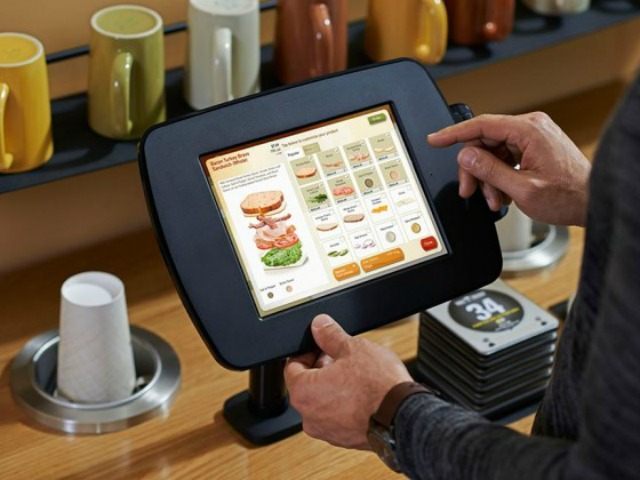The melancholy truth that America’s leftists, and the young people they exploit for political support, stubbornly refuse to learn is that the true minimum wage is zero. When the cost of labor is increased beyond its true value by government fiat, employers learn to make do with fewer workers.
The primary factor containing the damage from such market responses to increased labor cost is customer satisfaction. Beyond a certain point, it becomes impossible to cut jobs or productivity suffers too much. In a service-oriented business, such as food service, the customers have unhappy experiences at understaffed establishments and take their business elsewhere.
However, the CEO of one large restaurant chain warns that customers are now comfortable enough with automated systems to allow another huge round of job cuts in the near future. To put it simply, the government is pricing labor out of the market, and machines are standing ready to fill the gap.
The CEO in question, Ron Shaich of Panera Bread, didn’t really phrase this as a warning during his most recent quarterly earnings call. As reported by Business Insider, it was more like a confident prediction. “Labor is going to go down,” he said. “And as digital utilization goes up – like the sun comes up in the morning – it is going to continue to go up.”
“Digital utilization – you are seeing it happen in Panera today,” Shaich continued. “As it happens, it’s going to benefit larger organizations like Panera, who already have the technology in place.”
Indeed, a visitor to one of Shaich’s restaurants will immediately notice a high level of digital integration, as the “Panera 2.0” remodel sweeps across the nation. Newer Panera locations offer touch screens where customers can place their orders without speaking to wait staff. A human cashier is still available for those who prefer ordering the old-fashioned way, but the new system assumes a significant portion of the customer base will be comfortable plugging their order directly into the computer. Some locations even allow customers to order from their tables using cell phones or laptop computers.
Business Insider notes other restaurants, such as fast-food giant McDonald’s, pursuing similar automation paths. One of the early adopters was Chili’s, which put touch-screen computers at every table, allowing customers to pay their bills without human interaction, summon the wait staff for drink refills or desert orders, use points from the restaurant’s reward program for free items, and even pass the time playing games.
As with Panera, use of this system is optional, so customers can do everything with the assistance of human wait staff if they prefer, but the number of diners voluntarily using these electronic systems is providing valuable feedback to the industry. Shaich’s comments about automation reflect a growing awareness among restaurant management, and other service industry managers, that customers have grown comfortable with using digital technology at brick-and-mortar locations, perhaps in part because the explosion of e-commerce has taught them to see such systems as friendly and reliable. Experiments with such in-store automation largely failed a generation ago… but that was then, and this is now.
Business Insider cites Shaich claiming that rising labor costs were not the “explicit impetus” for Panera’s move to digital utilization. “We did our digital capabilities to give a better guest experience. It was never about labor,” he said.
But then, later in his conference call, the CEO admitted it was partially about labor, and the entire industry is thinking that way.
“All of us in the industry essentially view this as inflationary, just like if there was a broad-based increase in any commodity,” Shaich said about labor costs. “And labor is a commodity in that sense. It’s going to affect all of us, and we are all going to have to take price. That’s the reality of it, and I think it’s going to affect us all.”
Obviously, no company executive wants an expensive paradigm-shifting tech rollout to be perceived as a penny-pinching effort to replace human workers with machines. They’ll pitch their automation programs as exciting consumer-driven steps into a bright future of greater convenience, meeting the desire of young consumers to have an Amazon-style shopping experience everywhere they go.
Only after the “glorious dawn of a new digital era” pitch will they admit that, yes, they’re tired of having their profit margins shredded by socialist politicians, so they’re taking advantage of the rising digital comfort level among their customers to begin phasing out human employees. Today it’s touch screens replacing the time-consuming business of placing orders and paying bills; tomorrow it might be robot waiters. (The Business Insider piece mentions that electronics retailer Best Buy is already experimenting with using robots to move merchandise around inside its stores.)
This is a paradigm shift, and it will never be reversed — once the huge capital outlays for automation have been made, and customers have grown comfortable with it, those jobs will be gone for good. Contrary to left-wing rhetoric about “burger-flipper” jobs, young people in many demographic groups will miss these low-skill on-ramps to employment. And, unlike the banking industry and the automated teller machines President Obama once ignorantly blamed for the high unemployment rates of his presidency, these service industries won’t find new uses for the labor displaced by automation. They’re explicitly seeking ways to make do with fewer hours of high-cost, heavily burdened human labor… and, as the digital generation comes of age, such methods will be found.

COMMENTS
Please let us know if you're having issues with commenting.